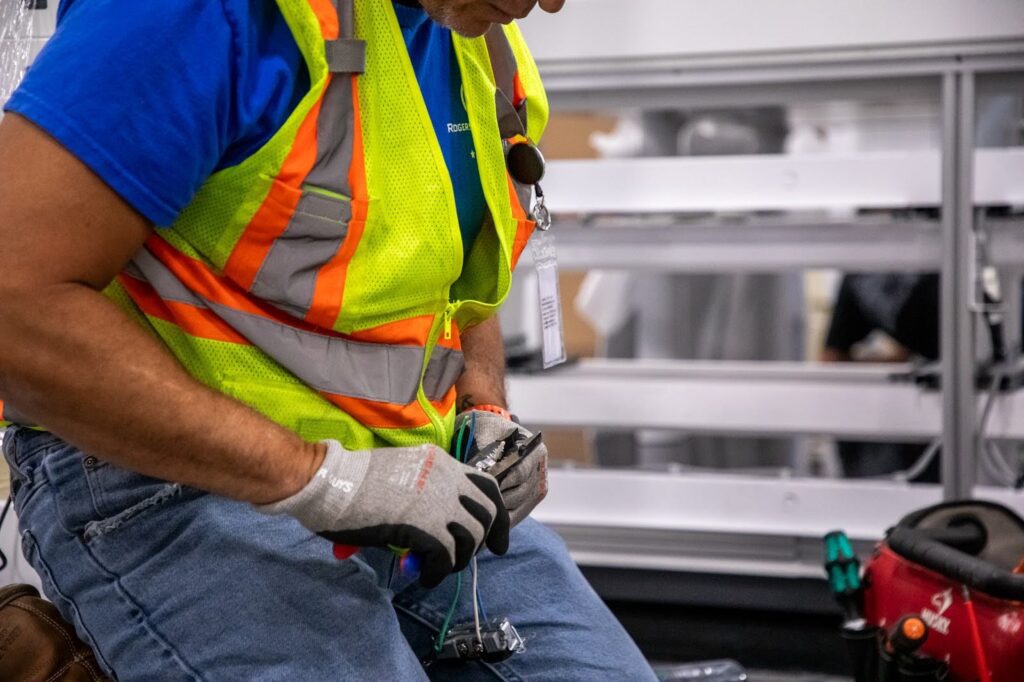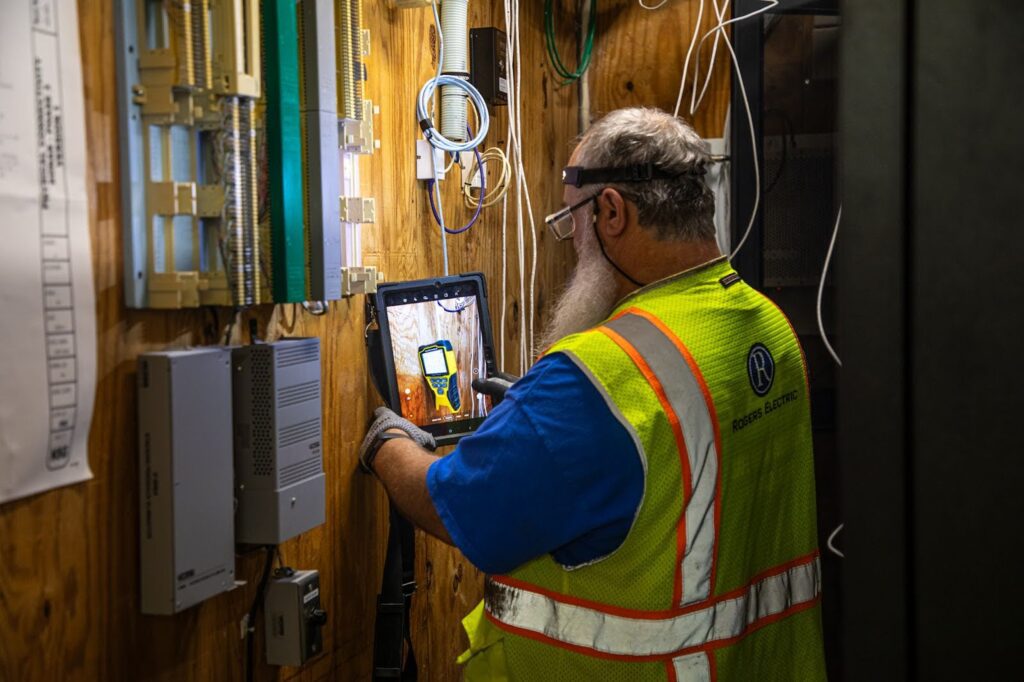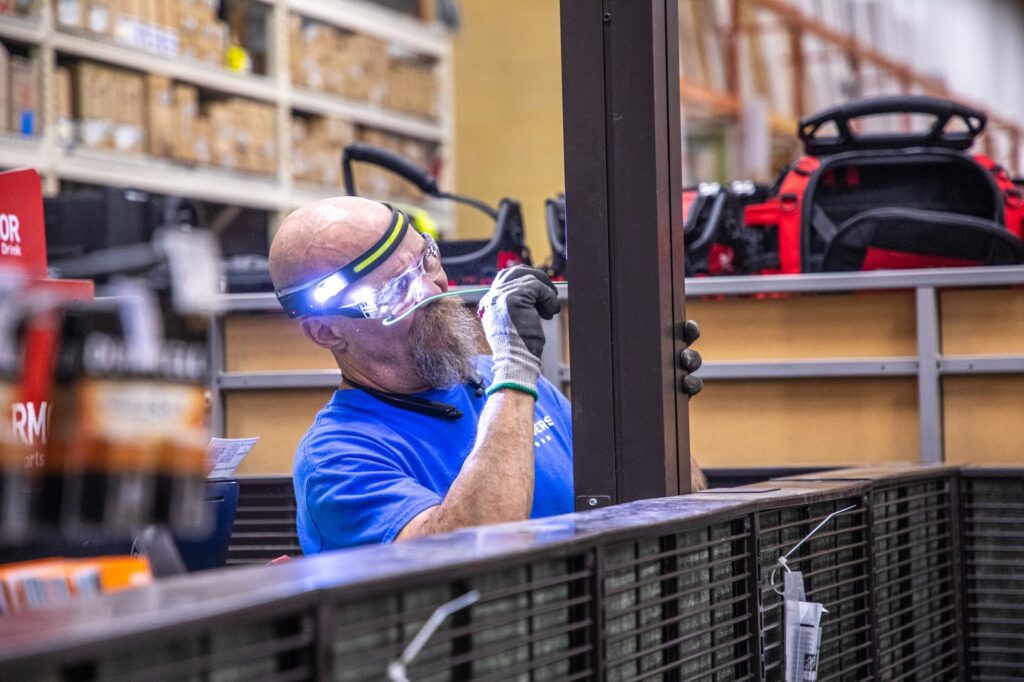How Electricians Power Warehouse Automation in 2025
In 2025, electricians are the force behind warehouse automation. Rogers Electric powers the tech that keeps operations efficient and future-ready.
Read MoreArtificial intelligence (AI) has introduced itself to every aspect of our lives, and the electrical industry is no exception. In fact, many industries have been reshaped by this automated technology.
As AI technology advances in the electrical industry, so does efficiency, safety, and customer service. Along with these advancements come challenges as well. Throughout this blog, we’ll answer the question: How has AI affected the electrical industry?
One of the most significant benefits of AI in the electrical industry is its ability to predict equipment failures before they happen. Traditionally, electrical maintenance was reactive—responding to breakdowns after they occurred. Or preventative, based on regular check-ups regardless of actual need.
AI introduces a new model: predictive maintenance. By analyzing data from sensors and historical performance, AI algorithms can predict when equipment is likely to fail and recommend timely maintenance. This proactive approach reduces downtime, extends the lifespan of equipment, and lowers maintenance costs. In return, this helps provide significant value to both electrical contractors and their clients.

AI is changing the way we manage energy, specifically in more sustainable and cost-effective ways. For example, smart grids that use AI can analyze how we use energy, predict how much we’ll need, and make sure electricity is distributed in the best way. In return, this makes our power supply more reliable and helps us use energy more efficiently. This means we waste less and can use renewable energy sources better.
For electricians, this means they can offer solutions to clients that help them use less energy and meet their sustainability goals. This makes AI an essential tool for managing energy in a modern way.
Safety is a top priority in the electrical industry. That being said, AI is helping to enhance safety protocols and procedures. Nowadays, AI-powered systems can keep an eye on work areas all the time, spot possible dangers, and warn workers or stop machines if needed.
For instance, AI can watch videos to check that everyone is following safety rules and wearing the right gear. This helps stop accidents, cuts down on how long things are out of action, and makes sure electricians have a safer workplace.
Technology has advanced to the point where it can assist with project management and design in the electrical contracting industry. These AI-powered tools help to make work processes smoother and more efficient by handling repetitive tasks and organizing resources better. This helps ensure that projects can be completed on schedule and within budget.
When it comes to design, AI can crunch numbers and make suggestions, so engineers can come up with smarter and more cost-effective plans in less time. With AI, it’s easier to figure out the best layouts, materials, and potential challenges, which makes the design process simpler and more effective. In summary, project efficiency can be more streamlined with AI tools.

Machine Learning (ML) is a part of artificial intelligence (AI) that powers technology like computers recognizing pictures, self-driving cars, and gadgets like Amazon’s Alexa. The idea of this technology is to mimic human learning tendencies, so they get better at things over time. This includes making accurate predictions or organizing information.
This technology helps electricians make customized solutions for their customers. ML can suggest tailored answers for specific problems by studying data patterns. For example, like making an energy-saving system or organizing electrical setups based on how they’re used. By offering custom solutions, electricians can meet their customers’ unique needs better.
AI technology helps contractors monitor and control electrical systems from anywhere in the world. This capability allows them to quickly solve problems without having to be on site, which saves time and money. Additionally, this will lead to faster response times and more efficient problem resolution.
For Rogers Electric, this technology means we could provide exceptional service to clients while minimizing travel and operational costs.
Artificial intelligence technology also helps businesses with their supply chain management strategies. It will predict demand for materials and equipment, manage inventory, and ensure availability of needed items.
This helps prevent having too much or too little of important materials, which can save time and money. AI can also find the best suppliers and forecast market trends, making sure companies stay ahead of the curve.
AI can significantly improve customer service in the electrical industry by providing more accurate estimates, faster response times, and personalized solutions. Chatbots powered by AI can handle basic questions, set up appointments, and keep customers informed about the status of their service requests. This can improve customer satisfaction and allow human resources to focus on more complex tasks.
Additionally, AI tools can help electrical service companies find and keep workers. It can do this by tailoring job ads, generating interview questions, and providing advanced training using virtual reality (VR). Technology like this will help Rogers Electric have more skilled and flexible workers, ready to take on the demands of modern electrical work.

Even though AI has its advantages, there are some challenges that the electrical industry needs to prepare for. Using AI involves investing a lot in technology and training. Many companies are cautious about using AI because it’s expensive to buy and set up advanced technologies like robots and software with machine learning abilities.
Additionally, people are also worried that some jobs will disappear as more tasks become automated. But AI is more likely to enhance what people can do rather than take their jobs, which creates new opportunities for electricians to focus on the more complicated and creative parts of their work.
Electrical projects pose a special challenge because each one has its own unique needs and conditions. This makes it difficult for AI programs to apply its knowledge from one project to another.
Moreover, there could be risks of cyber attacks on AI-powered systems. These attacks could manipulate data and lead to costly errors and safety risks.
Artificial intelligence (AI) is set to revolutionize the electrical industry by improving efficiency, safety, and customer service while reducing costs and downtime.
For companies like Rogers Electric, utilizing AI can provide a competitive edge and ensure they remain at the forefront of innovation in the electrical industry. By staying informed and open to new ideas, Rogers Electric can use AI to continue delivering exceptional service to our clients and driving the electrical industry forward.
As we move forward, it will be crucial to find the right balance between using AI and making sure our employees can keep learning and growing. We want to make sure that everyone is ready for the changes that new technology will bring.
By using AI in strategic ways, Rogers Electric can not only meet today’s demands of the electrical industry but also anticipate whatever challenges might come our way in the future.